Menus
- A cruiser in the S Series and Dark Custom range
- Screamin ‘Eagle Twin Cam 110 V-Twin of 1,801 cm3 delivering 156 Nm
- Discovery
- In the saddle
- In the city
- On highways and main roads
- On departmental
- Part-cycle
- Brakes
- Comfort / duo
- Conclusion
A cruiser in the S Series and Dark Custom range
Screamin ‘Eagle Twin Cam 110 V-Twin of 1,801 cm3 delivering 156 Nm
And 7! The Dark Custom family continues to grow at Harley-Davidson. Seen as a way to attract a younger and cooler clientele, it relies on their clean shapes, their dark colors, their minimalist and rebellious look at the same time.

The new Low Rider S therefore oversees this range from the top: as a reminder, this range consists, if we detail it by its increasing price, of the Street 750, the Sportster 883 Iron, the Sportster 1200 "48", the Roadster all freshly marketed, Street Bob, Fat Bob and therefore this new Low Rider S, posted 19,290 €. It is therefore top-of-the-range, as we will see a little below and we even dare to deviate a little from the suspense by declaring that this sum, to be tidy, is not usurped, even put into perspective with a classic Dyna Low Rider, sold from € 16,130.
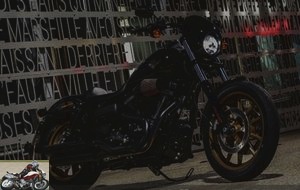
At Harley-Davidson, if there’s one thing we don’t joke about, it’s the 113-year-old heritage of this brand. The most learned of our readers therefore know that a Dyna Low Rider made its entry into the HD range in 1977. At the time, it was a question of filling a gap in the range between the Sportsters (which cubed 1000 cm3) and the Touring range. The Dyna Low Rider then cubed 1200 cm3 and from the beginning, the Dyna’s mission was to mix large engines in relatively compact chassis. Challenge filled with this Low Rider S and its V2 which cubes here 1801 cm3.
Discovery
Long. Low. Black. And damn aggressive. Before going into the details of its technical specifications, the Low Rider S is first and foremost an attitude. From the fork crown to the rear turn signal cabochons, the Low Rider S is black. You better like it, because it’s the only color available. Good news: customers love.
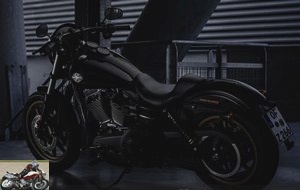
Let’s continue with the owner’s tour: the painting has a depth to challenge the thinking of white-shirted philosophers; the exhausts are black, as are the side covers, the slightly grainy material of which gives them a certain presence. In fact, there is nothing to say about the finish or the build quality: it’s beautiful.
Only beautiful? No, because certain details give that little cachet that makes all the difference and, for amateurs, we are therefore close to the sublime. What about the horn air filter, from the Screamin ‘Eagle performance line, which exudes performance and pays homage to the American imagination of Performance Bike and Muscle Car, with the proudly erected carburetor intake horns? above a cut-out hood. Either way, it’s an ode to performance, a hymn to the big V-engines with high unit displacement, which need those raging flows of fresh air and this tornado of 02 to greedily explode for octane in their cavities. The 1801 cm3 V2 therefore has no right to disappoint us.
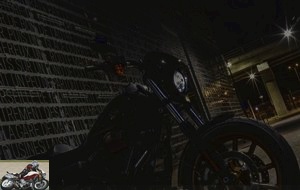
The alliance of black and bronze is not only delicate. It reinforces the personality of the whole and gives it a little more consistency. Those who would only view it with aesthetic aims are wrong. By their design and their colors, these wheels are indeed a tribute to the magnesium wheels of Formula 1 and Nascar cars of the 1970s. The message, now, becomes clearer: the Low Rider S promises to unload its mother. !
We will end the presentations with a tribute: both the logo on the tank and the small bulge like feminine hips on the sides of the saddle have nothing to do with style. These are allegories that directly refer to the XLCR, a muscle bike that Milwaukee had presented in 1980 and which is the holy grail of the brand’s collectors..

In the saddle
Like all contemporary Harley-Davidson’s, the Low Rider S has a keyless start. That’s one less concern. Because you might be intimidated by a machine that still weighs a little over 300 kilos with full tank (293 kilos dry). Fortunately, the extremely low center of gravity, the saddle perched at just 685 mm and the rather natural ergonomics make it much easier to grip..
Without a balancing shaft, but mounted flexibly in the frame, the V2 snorts with a jerk before settling down to idle at 1000 rpm. Does it vibrate? No he lives !
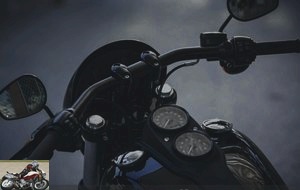
A few blows of empty gas: the 1800 shows little inertia and its exhaust lets out muffled rumblings, with a range that becomes subtly metallic past 2000 rpm, like a mahogany Riva which becomes lighter in the background. lane before returning to port.
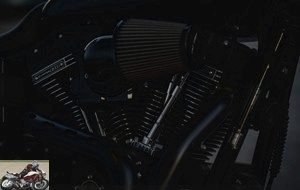
Let’s take our marks before letting go of the horses. As often with Harley, the levers are not adjustable. So do you have phalanges transplanted if it does not go well, cosmetic surgery has made a lot of progress lately. The stems are complete: separate turn signals, as always, but warnings on the right and on-board computer control on the left stalk. It allows you to scroll in the digital window of the odometer, the mileage, the two trips, the gear engaged, the time and the remaining range. We know cars that offer less! The icing on the cake: the cruise control control, at the bottom of the left stalk.
Two dials are placed on the tank console. Speedometer up, tachometer below which, like a sublime Yamaha TDR 250, requires you to look if its fly is closed to read the engine speed where, here, the red zone is located at 5500 rpm. But in either case, the character is such that with a usual twist, one drives to the ear. Especially since the Low Rider S is a generous bike with two open chacras, you can fully experience the road and the mechanics with it !
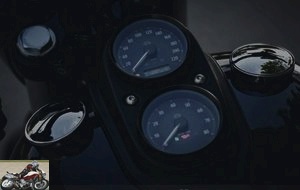
In the city
At very low speeds, the Low Rider S’s self-stability is certainly one of its qualities. Of course, the 1630mm wheelbase is no stranger to it, but this once again attests to the balance of the machine..
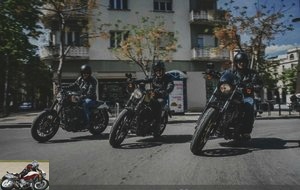
What is unique about Harley-Davidson’s "control feel" is that it offers rigor without ever being stiff. On this machine, you certainly live an experience, you are connected in a way to the gearbox gears and forks that select them, but without this being neither too much nor unpleasant. We order an engine room of a good big American engine.
And the big pistons do not deceive the goods! In a few meters, while you’re only 2000 rpm in first (barely enough to slip the clutch of a small or medium Japanese four-cylinder), the Low Rider S has already pushed you gently in the lower back, as if Shrek were giving you a nice pat on the back and you are already at 30 km / h having covered a few tens of meters, as if carried by a breath.
Magic of the laws of physics: in this case, the big pistons are more flexible than the small ones. And the Low Rider S, like the recently tested 1200 Roadster, posted a small 2000 rpm at 50 km / h in 3rd gear. But it can do even better, by taking a 1500 rpm in 4th, on a micron of gas. The vibrations remain sensitive in the handlebars and in the footrests, but they are undeniably part of the charm.
We finish by specifying that the neutral point is easy to find, unlike places devoted to practical aspects ….
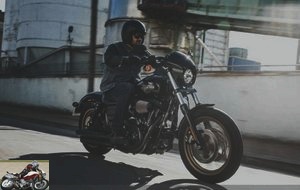
On highways and main roads
6th gear, 130 km / h: the V2 purrs at 3000 rpm. The vibrations felt at lower revs have disappeared and the crew is ready to cut the long highway strip indefinitely. Except that it is of no interest to the handlebars of such a machine (apart from connecting point A to point B and handling toll tickets). With a 17.8-liter tank, the range can then approach 300 kilometers.
Although the handlebars are relatively high, the position is not caricature and the ordeal can take a while, especially as the saddle and the suspensions are quite comfortable. Too bad, however, that the small fork crown sends air to the face. The stability is not to be questioned and the pickups at 3000 rpm are kind of copious, which makes you want to find more tormented routes to find out what this engine has in the belly.
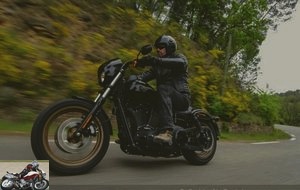
On departmental
At 90 km / h in 6th gear, the V2 barely spins above its idle speed: 2000 rpm. But the worst part is that he likes it, that it doesn’t pound and already allows it to pass without downshifting. On the other hand, it vibrates and its rod beats are sensitive in the footrests as in the handlebars. Persist in stating that it’s part of the personality of the machine !
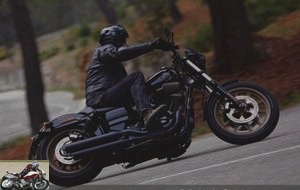
And speaking of personality, discovering all the facets of this Low Rider S opens up a wide range of sensations. And an equally generous smile. What an engine this Screamin ’Eagle 110 is! At 1,500 rpm, it’s both rough and silky. At 2000, he responds and clears his throat. At 3000, we arrive at the moment where he has the broadest shoulders, ready to send the 156Nm of torque he has into the connecting rods. End of the story ? Nay! At 3500 rpm, we go from torque to power and horsepower, not only does he have (94, to be precise), but he is also zealous in showing them to us. The vigor of the revs is astonishing for a machine of such a displacement. The Low Rider S devours the asphalt, throwing itself forward with a low growl and the breaker lands abruptly at 5500 rpm, without having enough time to catch our breath. Mazette! What health !
Especially since, unlike the two other models which are equipped with this mechanism, namely the Fat Boy S and the Softail Slim S, the Low Rider S can count on a chassis which is surprisingly at the level. Agile, thanks to its contained tires (a 160/70 x 17 at the rear), stable, good damping, it will of course end up scraping the asphalt if you insist. But by adopting the technique that goes well, that is to say by sacrificing the entry of the curve a little, we make up for lost time with cannonball accelerations at the exit. At a more leisurely pace, the comfort on bumpy roads is also surprising. Harley-Davisdon obviously did a good job on the suspensions.
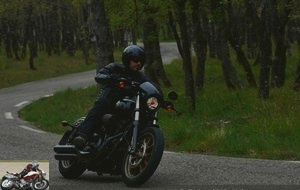
Part-cycle
Harley-Davidson is still not zealous on the technical sheets and we will just have to be content to know that the new cartridge fork has 43 mm diameter tubes and that the new rear emulsion shocks are charged with nitrogen , in addition to being adjustable in preload. However, there is no doubt that we are dealing with quality elements that provide rigor and comfort, which is never won in advance on these bikes of this weight..
The ground clearance, without being extraordinary, still allows you to have a little fun, with 29.5 ° of angle to the right before putting everything down and 30.5 ° to the left.
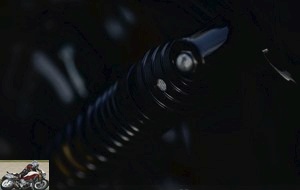
Brakes
Three disc brakes and, as always with Harley, a Bosch ABS whose sensors are stashed in the hubs, take care of stopping the set. Up front, the system uses fixed 4-piston calipers, with a 2-piston floating caliper at the rear. The two controls are perfectly dosable.
In absolute terms, the braking power is sufficient and at no time on the rough route we took did I scare myself under braking. Nevertheless, the dragster accelerations and the instantaneous reshootings do not call for any ambiguity: the Low Rider S really deposits and when it comes to slowing down its 300 kilos, the system does the trick but there is no nothing too much. That said, what proportion of owners will attack mountain roads like a hooligan as we have been able to do? You also need to know how to judge machines through the prism of their potential owner..
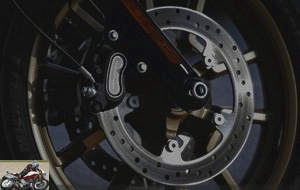
Comfort / duo
For the duo, bad news for Zezette (or Marco, let’s not be sectarian). Autolib, Uber and Bla Bla Car are your new friends, since originally the Low Rider S is a selfish machine. And sometimes selfishness is okay (but this is another debate).
Fortunately, the Harley-Davidson accessories catalog, which spans several hundred pages, has everything you need: saddle, footrest, possible sissy-bar..
On the rider side, however, this is also good news: the saddle is rather generous and the suspensions do the job well, even on small breaks. As for the vibrations, as we have said, they are present at low speed but not annoying and have never generated tingling.
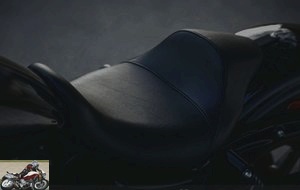
Conclusion
No need to beat around the bush: the new Harley-Davidson Low Rider S is a success, first of all because it is generous, but also because it is consistent and pleasant on all types of terrain, in the city, in cruising where even at a fast and flowing pace.
Easy to grip, agile, comfortable, rigorous, it relies on a large, enchanting V2 that is as pleasant to stroke with the handle as it is to force-feed big shots of gas. Gentle and helpful, he does not pretend to push and his constant availability is a delight for those who love engines with character, but not temper.
Admittedly, at € 19,290, it is obviously not within the reach of all budgets, but the generosity that it shows out of the box allows it to hit the nail on the head. Some machines, at Harley-Davidson as elsewhere, need an optimization kit (like "Stage 1") to deposit as much.
And since her black and bronze look is definitely in tune with the times ….
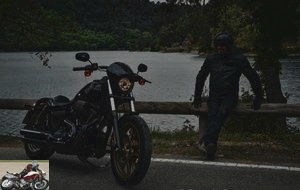
Strong points
- Fantastic 110 engine !
- Generous motorcycle
- Healthy frame
- Rigorous and comfortable suspensions
- Driving pleasure on all types of terrain
- Low discount to be expected
Weak points
- Braking just correct (because we can get there really fast!)
- Readability of the indicators in the tachometer dial
- Optional duo
The technical sheet of the Harley-Davidson Low Rider S
Test conditions
- Itinerary: 180 km between Saint-Tropez and Marseille by coastal roads, with a passage through Sainte-Baume, the Col de la Gineste and the route des crêtes.
- Motorcycle mileage: 600 km
- Problem encountered: none, apart from a few sparks left on the asphalt
- Competition: Victory Gunner, Suzuki M 1800R, Triumph Thunderbird Storm
Related articles
-
Harley-Davidson Freewheeler Test
V2, 1750 cm3, approx. 90 hp, 152 Nm at 3250 rpm, 492 kilos dry, from € 29,850 A stylish and stripped-down three-wheeler to discover the Harley-Davidson…
-
Harley-Davidson Forty-Eight and A2 test
1202 cm3, approx. 60 horsepower at 5500 rpm, 96 Nm at 3500 rpm, 252 kilos with full tank, from 12,410 € A minimalist and very stylish machine, generous…
-
Harley-Davidson Sport Glide 107 Test
Touring and sport at the same time: absolute versatility according to Harley V2, 1745 cm3, 84 hp at 5400 rpm, 145 Nm at 3250 rpm, 304 dry kilos, from €…
-
Harley-Davidson Street Bob 107 test
V2, 1745 cm3, 86 hp at 5020 rpm, 145 Nm at 3000 rpm, 297 kilos, from € 14,860 A change in philosophy from the Dyna family to the Softail family It’s been…
-
Harley-Davidson Street 750 A2 test
ABS, Euro4 engine, alarm and improved finishing details: from € 7,450 What is this small entry-level custom in a 47 hp flanged version worth? ? Eleven…
-
Harley-Davidson CVO Street Glide 114 test
V2, 1868 cm3, around 100 hp, 165 Nm, 398 kilos with full fuel, € 39,550 A certain vision of the exception made in Milwaukee and a really punchy 114…
-
Harley-Davidson Road King ‘107’ test
New 8-valve Milwaukee-Eight engine for this queen of the road 1745 cm3, approx. 90 horsepower, 150 N.m at 3250 rpm, 361 kilos dry, from 24,490 € Here, a…
-
Harley-Davidson Road Glide Ultra test
1700 cm3, 80 hp, 138 Nm of torque, cruise control, GPS, audio, € 27,850 A test over almost 4,000 kilometers from Paris to Porto via Wheels Waves and…
-
Harley-Davidson Road Glide CVO 117 test
Welcome to excess Harley-Davidson V2, 1923 cm3, 105 hp at 5450 rpm, 166 Nm at 3500 rpm, 385 kilos dry, from € 41,290 From when, too much is enough? What…
-
Harley-Davidson Fat Bob 114 test
V2, 1868 cm3, 94 hp at 5020 rpm, 155 Nm at 3000 rpm, 306 kilos, from € 19,660 Change of style and philosophy for this machine that migrates from the Dyna…